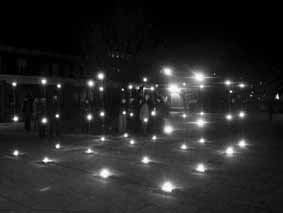When
dealing with the computer, facing the screen as some kind of partner in communication,
the frictions of such an "individual presumption" become obvious. On
one hand, we try to converse, speak, discuss - we expect outputs that somehow
relate to our inputs. On the other hand we constantly face program patterns
that result from very general (or very specific) considerations, that in no way
take notice of our individual needs, habits or peculiarities.
To solve
the problems that result from that kind of frictions, we need help: we have to
call people, read books, interweave in networks: to deal with the generality of
the problem, we have to integrate in a group - in a way.
As working
in front of a screen obviously implies both of these features - the individual impulse
and the general notion -one of my initial ideas for "interspace" was
to create a large screen and an enlarged keyboard (with ten times the number of
keys of a usual keyboard) to enable a group of people to commonly play with a
program - maybe a transformable picture or drawing. Still the basic pattern of
such a setup excluded movement in space, as well as gestural and sonic elements
- which I find crucial for communicative interaction. So I decided to use sonic
input and make space the interface - meaning that movement in a certain area
and the respective sound, either created by that movement or in the
environment, is recorded (input) processed in real-time and replayed (output).
Input- and output-area thus converse - we are finding us in a place that's
constantly re-capitulating and feedbacking its input. To mark and emphasize
this constant process the sonic input triggers a change of lightness on 48
halogen lights - whose patterns move according to the distribution of sound in
the spatial panorama.
